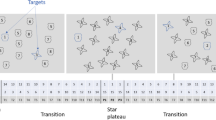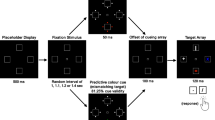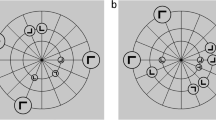Abstract
Attention fluctuates between optimal and suboptimal states. However, whether these fluctuations affect how we learn visual regularities remains untested. Using web-based real-time triggering, we investigated the impact of sustained attentional state on statistical learning using online and offline measures of learning. In three experiments (N = 450), participants performed a continuous performance task (CPT) with shape stimuli. Unbeknownst to participants, we measured response times (RTs) preceding each trial in real time and inserted distinct shape triplets in the trial stream when RTs indicated that a participant was attentive or inattentive. We measured online statistical learning using changes in RTs to regular triplets relative to random triplets encountered in the same attentional states. We measured offline statistical learning with a target detection task in which participants responded to target shapes selected from the regular triplets and with tasks in which participants explicitly re-created the regular triplets or selected regular shapes from foils. Online learning evidence was greater in high vs. low attentional states when combining data from all three experiments, although this was not evident in any experiment alone. On the other hand, we saw no evidence of impacts of attention fluctuations on measures of statistical learning collected offline, after initial exposure in the CPT. These results suggest that attention fluctuations may impact statistical learning while regularities are being extracted online, but that these effects do not persist to subsequent tests of learning about regularities.





Similar content being viewed by others
Data and code availability
Data and code are available at https://osf.io/46grb/?view_only=53d7f6d3e5374a02a30021444b1ebee0.
Notes
Shape stimuli were presented for 800 ms, and mean RT for frequent-category trials was 379.39 ms (SD = 121.28 ms). Thus, the lack of RT recording during the ITI (800–1,000 ms after stimulus onset) did not likely result in a large number of missed responses. Participants missed (i.e., failed to respond to) 2.96% frequent-category trials on average.
References
Batterink, L. J., & Paller, K. A. (2017). Online neural monitoring of statistical learning. Cortex, 90, 31–45. https://doi.org/10.1016/j.cortex.2017.02.004
Chun, M. M., Golomb, J. D., & Turk-Browne, N. B. (2011). A taxonomy of external and internal attention. Annual Review of Psychology, 62(1), 73–101. https://doi.org/10.1146/annurev.psych.093008.100427
Conway, C. M., & Christiansen, M. H. (2005). Modality-constrained statistical learning of tactile, visual, and auditory sequences. Journal of Experimental Psychology: Learning, Memory, and Cognition, 31(1), 24–39. https://doi.org/10.1037/0278-7393.31.1.24
Conway, C. M., & Christiansen, M. H. (2006). Statistical learning within and between modalities: Pitting abstract against stimulus-specific representations. Psychological Science, 17(10), 905–912. https://doi.org/10.1111/j.1467-9280.2006.01801.x
deBettencourt, M. T., Keene, P. A., Awh, E., & Vogel, E. K. (2019). Real-time triggering reveals concurrent lapses of attention and working memory. Nature Human Behaviour, 3(8), 808–816. https://doi.org/10.1038/s41562-019-0606-6
deBettencourt, M. T., Norman, K. A., & Turk-Browne, N. B. (2018). Forgetting from lapses of sustained attention. Psychonomic Bulletin & Review, 25(2), 605–611. https://doi.org/10.3758/s13423-017-1309-5
de Leeuw, J. R. (2015). jsPsych: A JavaScript library for creating behavioral experiments in a web browser. Behavior Research Methods, 47(1), 1–12. https://doi.org/10.3758/s13428-014-0458-y
Esterman, M., Noonan, S. K., Rosenberg, M., & DeGutis, J. (2013). In the zone or zoning out? tracking behavioral and neural fluctuations during sustained attention. Cerebral Cortex, 23(11), 2712–2723. https://doi.org/10.1093/cercor/bhs261
Esterman, M., & Rothlein, D. (2019). Models of sustained attention. Current Opinion in Psychology, 29, 174–180. https://doi.org/10.1016/j.copsyc.2019.03.005
Faul, F., Erdfelder, E., Lang, A.-G., & Buchner, A. (2007). G*Power 3: A flexible statistical power analysis program for the social, behavioral, and biomedical sciences. Behavior Research Methods, 39(2), 175–191. https://doi.org/10.3758/bf03193146
Fiser, J., & Aslin, R. N. (2002). Statistical learning of higher-order temporal structure from visual shape sequences. Journal of Experimental Psychology: Learning, Memory, and Cognition, 28(3), 458–467. https://doi.org/10.1037/0278-7393.28.3.458
Forest, T. A., Finn, A. S., & Schlichting, M. L. (2022). General precedes specific in memory representations for structured experience. Journal of Experimental Psychology: General, 151, 837–851. https://doi.org/10.1037/xge0001104
Franco, A., Gaillard, V., Cleeremans, A., & Destrebecqz, A. (2015). Assessing segmentation processes by click detection: Online measure of statistical learning, or simple interference? Behavior Research Methods, 47(4), 1393–1403. https://doi.org/10.3758/s13428-014-0548-x
Frost, R., Armstrong, B. C., & Christiansen, M. H. (2019). Statistical learning research: A critical review and possible new directions. Psychological Bulletin, 145(12), 1128–1153. https://doi.org/10.1037/bul0000210
Gómez, D. M., Bion, R. A. H., & Mehler, J. (2011). The word segmentation process as revealed by click detection. Language and Cognitive Processes, 26(2), 212–223. https://doi.org/10.1080/01690965.2010.482451
Hakim, N., deBettencourt, M. T., Awh, E., & Vogel, E. K. (2020). Attention fluctuations impact ongoing maintenance of information in working memory. Psychonomic Bulletin & Review, 27(6), 1269–1278. https://doi.org/10.3758/s13423-020-01790-z
Himberger, K., Finn, A., Honey, C. J. (2019). Reconsidering the Automaticity of Visual Statistical Learning. PsyArXiv. https://doi.org/10.31234/osf.io/r659w
Hunt, R. H., & Aslin, R. N. (2001). Statistical learning in a serial reaction time task: Access to separable statistical cues by individual learners. Journal of Experimental Psychology: General, 130(4), 658–680. https://doi.org/10.1037/0096-3445.130.4.658
Kiai, A., Melloni, L. (2021). What canonical online and offline measures of statistical learning can and cannot tell us [Preprint]. Neuroscience.https://doi.org/10.1101/2021.04.19.440449
Kim, R., Seitz, A., Feenstra, H., & Shams, L. (2009). Testing assumptions of statistical learning: Is it long-term and implicit? Neuroscience Letters, 461(2), 145–149. https://doi.org/10.1016/j.neulet.2009.06.030
Krogh, L., Vlach, H., Johnson, S. (2013). Statistical Learning Across Development: Flexible Yet Constrained. Frontiers in Psychology, 3. https://doi.org/10.3389/fpsyg.2012.00598
Kuznetsova, A., Brockhoff, P. B., & Christensen, R. H. B. (2017). lmerTest package: Tests in linear mixed effects models. Journal of Statistical Software, 82, 1–26. https://doi.org/10.18637/jss.v082.i13
Lenth, R. V., Bolker, B., Buerkner, P., Giné-Vázquez, I., Herve, M., Jung, M., Love, J., Miguez, F., Riebl, H., Singmann, H. (2023). Emmeans: Estimated marginal means, aka least-squares means (1.8.9). https://cran.rproject.org/web/packages/emmeans/index.html
Liu, H., Forest, T. A., Duncan, K., & Finn, A. S. (2023). What sticks after statistical learning: The persistence of implicit versus explicit memory traces. Cognition, 236, 105439. https://doi.org/10.1016/j.cognition.2023.105439
Musz, E., Weber, M. J., & Thompson-Schill, S. L. (2015). Visual statistical learning is not reliably modulated by selective attention to isolated events. Attention, Perception, & Psychophysics, 77(1), 78–96. https://doi.org/10.3758/s13414-014-0757-5
Nissen, M. J., & Bullemer, P. (1987). Attentional requirements of learning: Evidence from performance measures. Cognitive Psychology, 19(1), 1–32. https://doi.org/10.1016/0010-0285(87)90002-8
Robertson, I. H., Manly, T., Andrade, J., Baddeley, B. T., & Yiend, J. (1997). “Oops!”: Performance correlates of everyday attentional failures in traumatic brain injured and normal subjects. Neuropsychologia, 35(6), 747–758. https://doi.org/10.1016/s0028-3932(97)00015-8
Rosenberg, M. D., Scheinost, D., Greene, A. S., Avery, E. W., Kwon, Y. H., Finn, E. S., Ramani, R., Qiu, M., Constable, R. T., & Chun, M. M. (2020). Functional connectivity predicts changes in attention observed across minutes, days, and months. Proceedings of the National Academy of Sciences, 117(7), 3797–3807. https://doi.org/10.1073/pnas.1912226117
Saffran, J. R., Newport, E. L., Aslin, R. N., Tunick, R. A., & Barrueco, S. (1997). Incidental language learning: Listening (and learning) out of the corner of your ear. Psychological Science, 8(2), 101–105. https://doi.org/10.1111/j.1467-9280.1997.tb00690.x
Sarter, M., Givens, B., & Bruno, J. P. (2001). The cognitive neuroscience of sustained attention: Where top-down meets bottom-up. Brain Research Reviews, 35(2), 146–160. https://doi.org/10.1016/S0165-0173(01)00044-3
Schapiro, A. C., Kustner, L. V., & Turk-Browne, N. B. (2012). Shaping of object representations in the human medial temporal lobe based on temporal regularities. Current Biology, 22(17), 1622–1627. https://doi.org/10.1016/j.cub.2012.06.056
Schapiro, A. C., Rogers, T. T., Cordova, N. I., Turk-Browne, N. B., & Botvinick, M. M. (2013). Neural representations of events arise from temporal community structure. Nature Neuroscience, 16(4), 486–492. https://doi.org/10.1038/nn.3331
Schapiro, A. C., Gregory, E., Landau, B., McCloskey, M., & Turk-Browne, N. B. (2014). The necessity of the medial temporal lobe for statistical learning. Journal of Cognitive Neuroscience, 26(8), 1736–1747. https://doi.org/10.1162/jocn_a_00578
Schapiro, A. C., Turk-Browne, N. B., Norman, K. A., & Botvinick, M. M. (2016). Statistical learning of temporal community structure in the hippocampus. Hippocampus, 26(1), 3–8. https://doi.org/10.1002/hipo.22523
Schapiro, A. C., Turk-Browne, N. B., Botvinick, M. M., & Norman, K. A. (2017). Complementary learning systems within the hippocampus: A neural network modelling approach to reconciling episodic memory with statistical learning. Philosophical Transactions of the Royal Society B: Biological Sciences, 372(1711), 20160049. https://doi.org/10.1098/rstb.2016.0049
Siegelman, N., Bogaerts, L., Kronenfeld, O., & Frost, R. (2018). Redefining “learning” in statistical learning: what does an online measure reveal about the assimilation of visual regularities? Cognitive Science, 42(S3), 692–727. https://doi.org/10.1111/cogs.12556
Smith, W. D. (1995). Clarification of Sensitivity Measure A’. Journal of Mathematical Psychology, 39(1), 82–89. https://doi.org/10.1006/jmps.1995.1007
Tóth, B., Janacsek, K., Takács, Á., Kóbor, A., Zavecz, Z., & Nemeth, D. (2017). Dynamics of EEG functional connectivity during statistical learning. Neurobiology of Learning and Memory, 144, 216–229. https://doi.org/10.1016/j.nlm.2017.07.015
Turk-browne, N. B., Jungé, J. A., Scholl, B. J. (2005). The automaticity of visual statistical learning. Journal of Experimental Psychology: General, 552–564.
Turk-Browne, N. B., Scholl, B. J., Chun, M. M., & Johnson, M. K. (2009). Neural evidence of statistical learning: efficient detection of visual regularities without awareness. Journal of Cognitive Neuroscience, 21(10), 1934–1945. https://doi.org/10.1162/jocn.2009.21131
Vosgerau, J., Nelson, L. D., Simonsohn, U., & Simmons, J. P. (2019). 99% Impossible: A Valid, or Falsifiable, Internal Meta-Analysis (SSRN Scholarly Paper 3271372). https://doi.org/10.2139/ssrn.3271372
Wakeland-Hart, C. D., Cao, S. A., deBettencourt, M. T., Bainbridge, W. A., & Rosenberg, M. D. (2022). Predicting visual memory across images and within individuals. Cognition, 227, 105201. https://doi.org/10.1016/j.cognition.2022.105201
Wang, B., & Theeuwes, J. (2018). Statistical regularities modulate attentional capture. Journal of Experimental Psychology: Human Perception and Performance, 44(1), 13–17. https://doi.org/10.1037/xhp0000472
Zhao, J., Al-Aidroos, N., & Turk-Browne, N. B. (2013). Attention is spontaneously biased toward regularities. Psychological Science, 24(5), 667–677. https://doi.org/10.1177/0956797612460407
Acknowledgements
We thank Jiaying Zhao for sharing the task stimuli. We also thank Omid Kardan for his analysis suggestions. This work was supported by National Science Foundation BCS-2043740 (M.D.R.) and resources provided by The University of Chicago Research Computing Center.
Author information
Authors and Affiliations
Corresponding authors
Ethics declarations
Conflict of interest
None declared.
Additional information
Publisher's Note
Springer Nature remains neutral with regard to jurisdictional claims in published maps and institutional affiliations.
Supplementary Information
Below is the link to the electronic supplementary material.
Rights and permissions
Springer Nature or its licensor (e.g. a society or other partner) holds exclusive rights to this article under a publishing agreement with the author(s) or other rightsholder(s); author self-archiving of the accepted manuscript version of this article is solely governed by the terms of such publishing agreement and applicable law.
About this article
Cite this article
Zhang, Z., Rosenberg, M.D. Assessing the impact of attention fluctuations on statistical learning. Atten Percept Psychophys (2023). https://doi.org/10.3758/s13414-023-02805-2
Accepted:
Published:
DOI: https://doi.org/10.3758/s13414-023-02805-2




